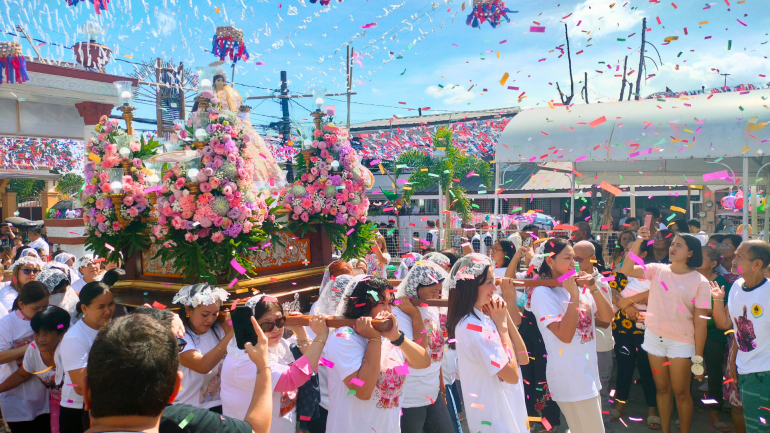Why men are forbidden to touch this image of St. Agnes in the Philippines

Every middle of January, the coastal borders of the province of Bulacan in the Philippines come alive with festivities.
After taking a short respite from the Christmas season, the small community of Santa Ines in Bulakan joyfully comes together to honor their local patroness, Saint Agnes of Rome.
Named after the localized name of Saint Agnes, the neighborhood of Santa Ines is filled with colorful flags and echoes of poetic songs during the Virgin and Martyr’s feast day every January 21. At a glance, it possesses the usual fiesta traditions of Filipinos during such religious memorials. But this particular festival has a unique, if not unusual, element—one that draws pious devotees and curious onlookers alike.
At the heart of Santa Ines stands a chapel that houses an 18th-century image of Saint Agnes. When it comes to venerating the statue, a longstanding tradition has been set by the local faithful: no men are allowed to touch or carry it.
Fetched from the river
According to oral tradition, the image was discovered by a fisherman during a vicious storm, where he saw the statue snagged at one end of his boat.
Upon coming ashore, he tried to carry the image but found it too heavy for one person to lift. Some fishermen came to his aid, but even with multiple men struggling to lift the statue, it would not move even a bit.
Finally, a woman—just one woman—approached them to lend a hand. To their surprise, she was able to carry the statue all by herself.
Considered a mystic event by the locals, they promptly venerated the statue, which they identified to be Saint Agnes due to the lamb and palm frond she holds—her two most common attributes. The body of the image is made of wood, and the hands and head are ivory.
The exact date of these events is unknown, but it was presumed around 1765 when records show that the community’s name was changed from the old Pariahan to the new Santa Ines.
In addition, the year 1764 is etched on the base of the image, which may have been the year of its discovery.
This story was the basis of their tradition to forbid men from touching or carrying the image. A long list of miracles has been attributed to the intercession of Santa Ines, deepened further by the veneration of this antique image. Illnesses were cured, near-impossible intentions were heard, and people were saved from serious harm.
However, locals also claim that chains of unfortunate events and devastating calamities happen to their community whenever men break their everlasting rule and touch the image.
A holy struggle for chastity
This local custom may seem fanatical to some, but the practice of prohibiting men from touching the statue mirrors the very life the saint led.
Agnes was born in Rome in 291 A.D., and her family's wealth attracted many suitors. But the girl, steadfast in her love for Christ, refused all of them and claimed that Jesus is her “only spouse.”
Legends say that the men she turned down, insulted by her dismissal, submitted her name to the authorities for being a Christian. After being put in chains and forced to enter a prostitution house, Agnes remained true to her faith.
She died by beheading at the age of 12 or 13. Those who watched her execution described her not as a girl trembling in fear but as a woman holding her head high like a bride at her wedding.
The Greek word for chaste inspired her name, Agnes. Coincidentally, it also has a similar sound to the Latin word “agnus,” which means lamb.
Meeting of young and old
Women appropriately carry Santa Ines' image during processions.
Known as Mamamasan, these ladies are a mix of young and old parishioners, all eager to look after the saint with solemnity and a touch of grandeur. Some have been doing it for decades, and others have inherited the practice from their elders.
According to Hanna Hikari Galman, one of the caretakers of the image, every woman in their community is welcome to volunteer for this noble duty.
“Anyone can join in carrying Santa Ines as long as they can. Their age does not matter,” she said.
She also said that with their collective effort, no man has ever touched the image in recent years.
“We do our best to remind men to avoid touching her,” said Galman.
Several Mamamasan flank Santa Ines during processions to deter men from even trying to go near the statue. And for additional security, signage telling men to keep away is attached around her image.
Furthermore, Galman explained that the honor of carrying Santa Ines is not exclusive to those living within their community: “We also give outsiders a chance to become a Mamamasan.”
Santa Ines' procession takes place twice on her feast day: in the morning and the evening.
For the evening procession, the image visits a devotee's home for the annual Luante, a practice of reciting poems and singing hymns retelling the life and morals of Saint Agnes. The province of Bulacan is known for its poets.
A silent witness of vibrant faith
For more than 200 years, the tradition attached to Santa Ines in Bulacan in the Philippines has been well preserved for posterity.
Just like the perfect mix of young and old women serving in her chapel, the image is a lasting symbol of how popular piety, devotion, and faith can blend according to the teachings of Christ.
Those who flock to this small neighborhood will find not only a historic statue with an uncommon practice toward it but God’s everlasting love and healing are fully transparent to the Filipino locals residing there.
There is no better person to remind us, particularly the men, of the commitment and resilience of women in following the Lord than Saint Agnes of Rome, the one who chose to offer her life rather than set aside her Holy Spouse.












